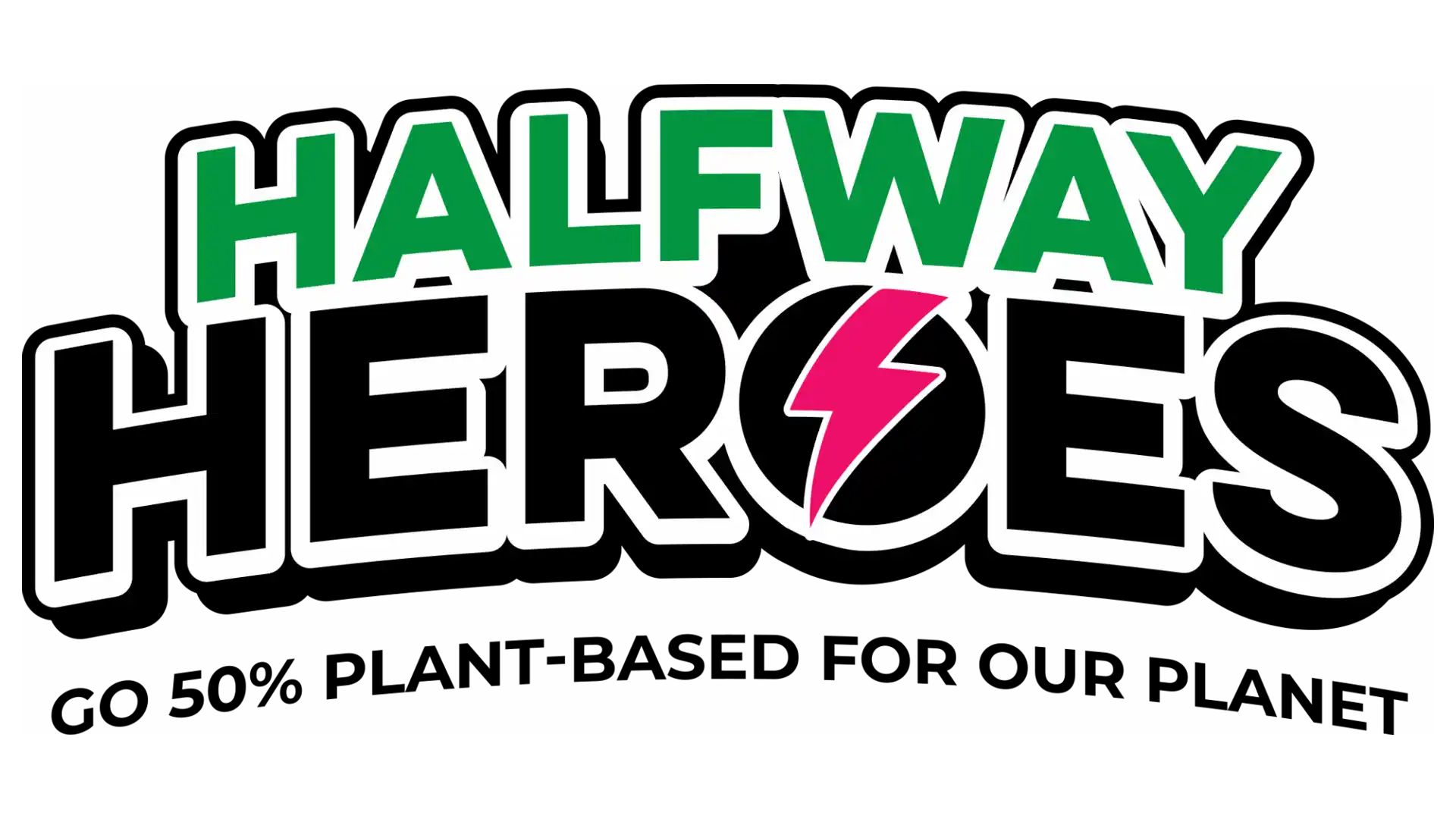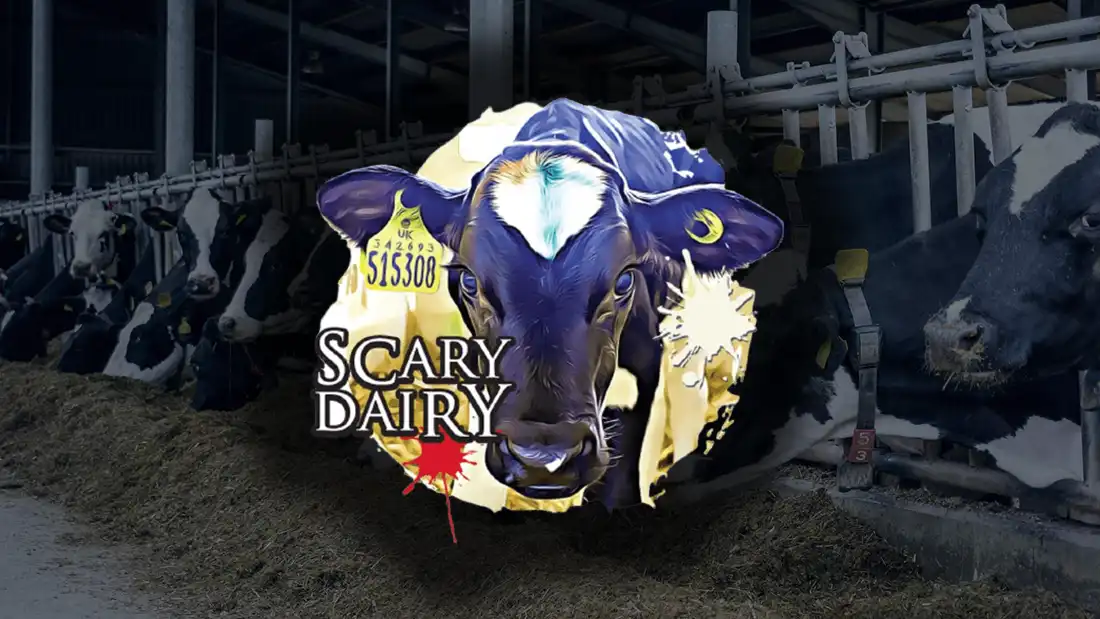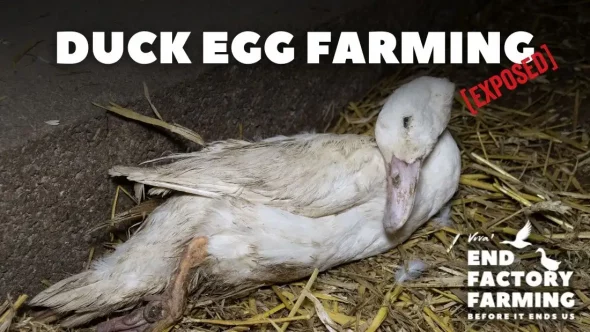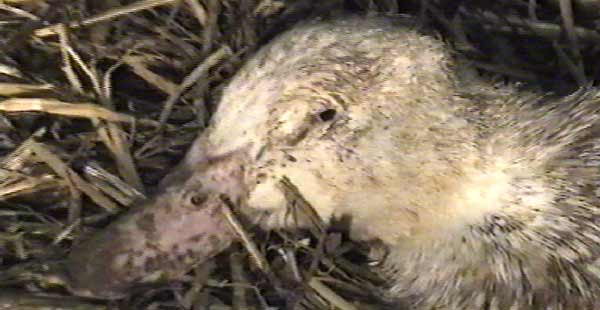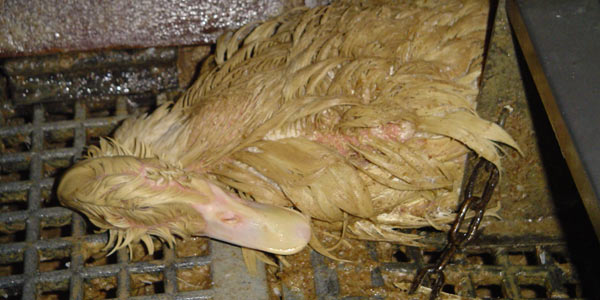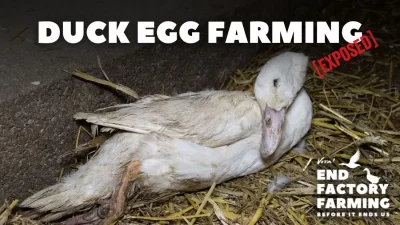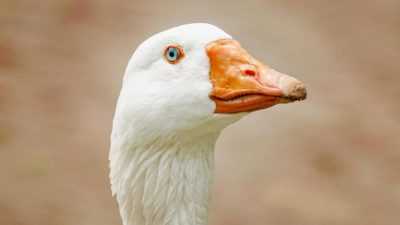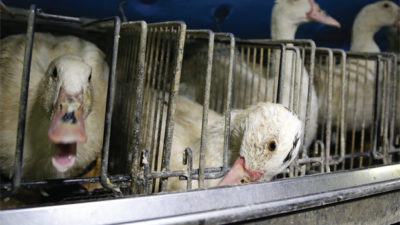How Ducks and Geese Are Farmed and Killed

- When a female duck lays eggs, she often places a few of them in another female’s
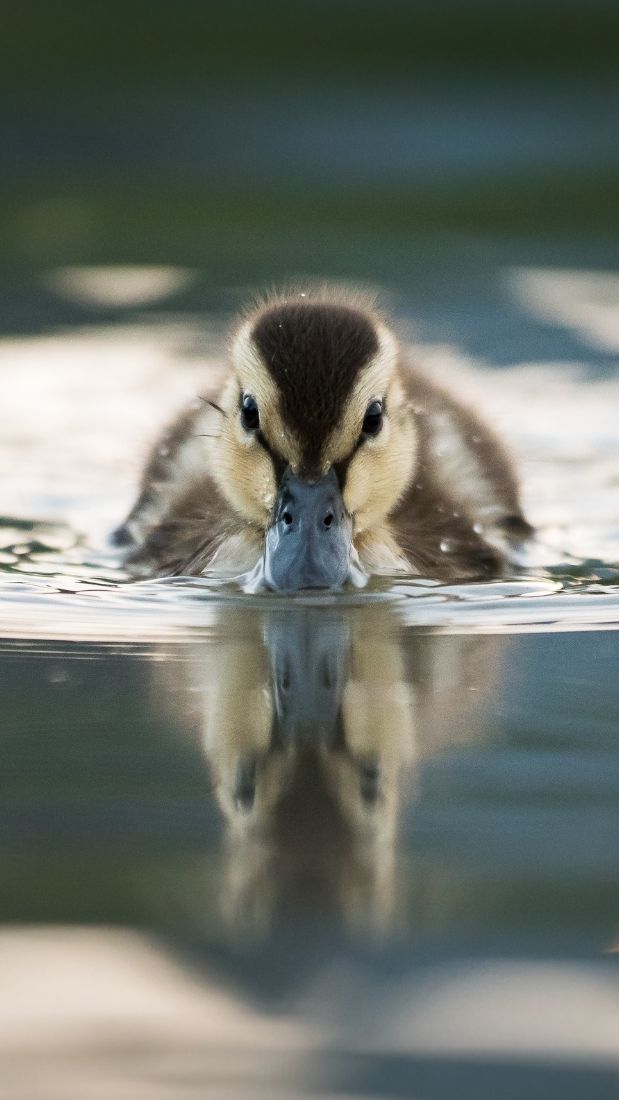 nest. Scientists say she does this so that if something happens to her at least some of her young will survive.7Specktor, B., 2019. ‘This Duck Supermom Leads 76 Ducklings in Amazing, Adorable Photo’. Livescience, 31 July. Available at https://www.livescience.com/63221-mama-merganser-76-ducklings.html [Accessed 28 April 2020].
nest. Scientists say she does this so that if something happens to her at least some of her young will survive.7Specktor, B., 2019. ‘This Duck Supermom Leads 76 Ducklings in Amazing, Adorable Photo’. Livescience, 31 July. Available at https://www.livescience.com/63221-mama-merganser-76-ducklings.html [Accessed 28 April 2020]. - A wildlife photographer in Minnesota captured a single mother duck followed by 76 ducklings on Lake Bemidij. An extraordinary sighting! Were they all hers? No, mum was a type of duck called a Common Merganser. They form creches where females leave their ducklings with an older female, experienced at raising babies. Though even for these collaborative birds, 76 is a lot!8Mervosh, S., 2018. ‘1 Hen, 76 Ducklings: What’s the Deal With This Picture?’. The New York Times, 24 July. Available at https://www.nytimes.com/2018/07/24/science/merganser-ducklings-photo.html [Accessed 28 April 2020].
- Migrating geese fly in a ‘V’ formation to conserve energy and to be able to keep track of other geese in the group.9Yong, E., 2014. ‘Birds That Fly in a V Formation Use An Amazing Trick’. National Geographic, 15 January. Available at https://www.nationalgeographic.com/science/phenomena/2014/01/15/birds-that-fly-in-a-v-formation-use-an-amazing-trick/ [Accessed 29 April 2020] Pretty clever!
- Migrating Mallards can fly up to 800 miles in just eight hours.10Checkett, M., Young, M., 2020. ‘Amazing Waterfowl Facts’. Ducks. Available at https://www.ducks.org/conservation/waterfowl-research-science/amazing-waterfowl-facts [Accessed 29 April 2020]. Perhaps not surprisingly, after such a stupendous effort, they will feed and rest for up to seven days to replenish their energy.
- Canada geese stay with their mates for life. At two or three years old they start searching for their life partner and only if their mate dies do they look for a new one.11American Exhibition, 2020. ‘Canada goose information, photos and facts’. Available at https://forum.americanexpedition.us/canada-goose-information-facts-photos-and-artwork [Accessed 29 April 2020].
- Ducks and geese’s feathers are waterproof. Both birds have a ‘preen gland’ which produces oil so that when they preen with their beak, they comb the oil over their feathers and that’s what makes them waterproof.12Daniels, T., 2018. ‘Wet Feathers’. Poultrykeeper, 23 October. Available at https://poultrykeeper.com/external-problems/wet-feather/ [Accessed 29 April 2020].
- The Greylag goose is Britain’s only native breeding goose.
Ducks and water
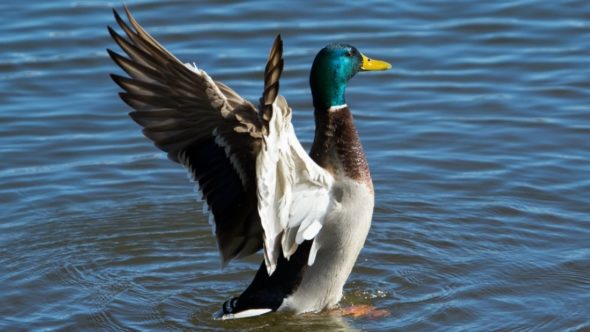
Ducks and geese are aquatic animals and spend a lot of their time in water. Their whole anatomy is built for life on water – webbed feet for swimming and their bills are brilliantly designed to sieve food particles from rivers and ponds. Ducks naturally use open water for head-dipping, swimming, dabbling and bathing.1Rodenburg, T. B., Bracke, M. B. M., Berk, J., Cooper, J., Faure, J. M., Guémené, D., Guy, G., Harlander, A., Jones, T., Knierim, U., Kuhnt, K., Pingel, H., Reiter, K., Serviére, J. and Ruis, M. A. W., 2005. ‘Welfare of ducks in European duck husbandry systems’. World’s Poultry Science Journal. Cambridge University Press on behalf of World’s Poultry Science Association, 61(4), pp. 633–646.Available at https://www.tandfonline.com/doi/abs/10.1079/WPS200575?journalCode=twps20 [Accessed 29 April 2020].
Viva! has rescued ducks several times and we discovered that their need to be in water was astonishing.
Twice, Viva! were given little 20 day-old ducklings which we reared to maturity and were able to observe just how vital their relationship is with water. Ducklings are too young to produce oil in their preen glands and rely on oil from their mothers’ feathers and without it they become sodden and risk drowning. Viva! allowed them only shallow drinking points until their fluffy duckling down was replaced by feathers and they were able to preen.
Each time the drinking water was changed the ducklings became really excited. Clearly, water was imprinted in their genetic make-up as being of top importance. Once the ducklings had grown adult feathers they were allowed on to ponds where they spent most of their time.2Gellatley, J., Druce, C. andKerswell, J., 2006. ‘Ducks out of Water, A report on the UK duck industry’. Bristol, UK. Available at https://www.viva.org.uk/sites/default/files/duck-report-2009.pdf [Accessed 29 April 2020].
Later, Viva! were given two seven-week old ducks who had never been on water. When we lowered them on to it for the first time, they were ecstatic! From then on, they spent four-fifths of their time on water – it was fundamental to their lives and they would even dash to anyone carrying a bowl of it, jump in it, splash, play and eat their food from it.
These observations are backed up by scientific research that shows duck welfare is fundamentally linked to their access to water.3Jones, T.A., Waitt, C.D. and Dawkins, M.S., 2009. ‘Water off a duck’s back: Showers and troughs match ponds for improving duck welfare’. Applied animal behaviour science, 116(1), pp.52-57. Available at https://www.sciencedirect.com/science/article/abs/pii/S0168159108001950 [Accessed 29 April 2020] Water is essential for their physical health, for them to be able to clean their eyes, nose and feathers.
In factory farms, ducks are denied any access to water apart from that in their drinkers where at most they can dip their head under water. The farming industry concentrates on increasing productivity and profit margins and completely disregards the animal’s needs.
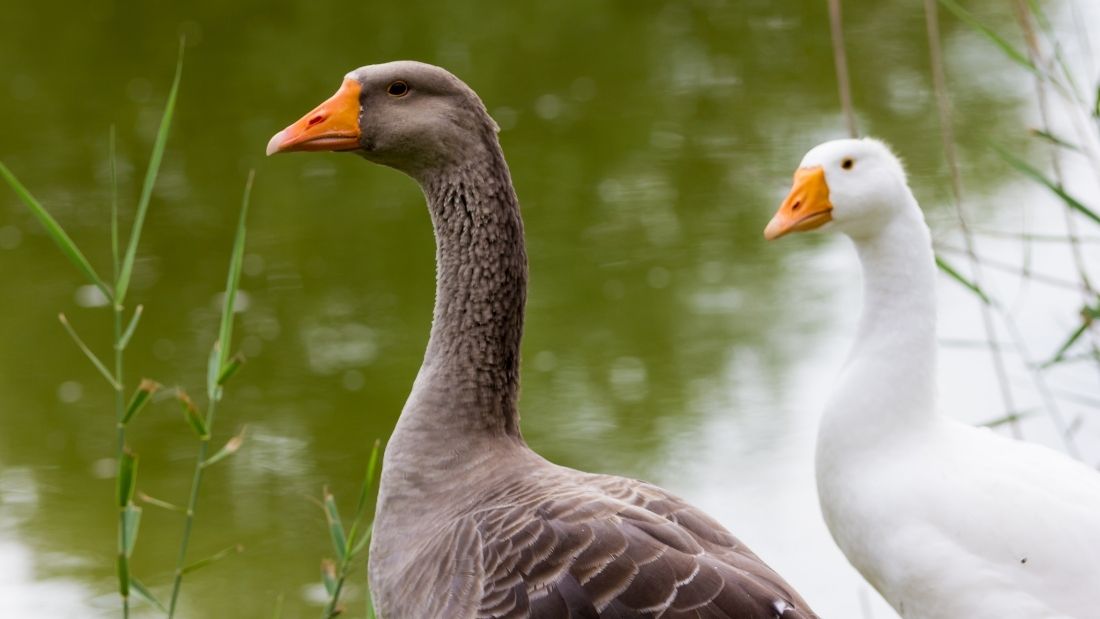
Ducks, geese and swans are classified as medium to large-sized aquatic birds and are referred to collectively as waterfowl. They are identifiable by their medium to long necks, short legs, mostly short, broad bills and front toes joined by webs, which enable them to swim fast.1RSPB, 2020a. ‘Ducks, geese and swans’. Available at https://www.rspb.org.uk/birds-and-wildlife/wildlife-guides/bird-a-z/ducks-geese-and-swans/ [Accessed 28 April 2020]. Ducks are divided into ‘diving ducks’, who dive underwater for their food – several are found at sea, and ‘surface feeders’, who rarely dive.
Geese are divided into ‘black geese’ and ‘grey geese’.
Where do ducks and geese descend from?
They are both members of the Anatidae family, which live across all continents except for the Antarctic region, and comprise between 140 and 175 bird species.
All domesticated or farmed ducks originate from the Mallard, with the exception of the Muscovy, which has distinct origins in South America.
There are two main types of domestic geese. The first are thought to have their origins in Europe, descendants of the wild Greylag goose (Anser anser) and the second are thought to have their origins in Asia, descendants of the wild Swan goose (Anser cygnoides).
Wild ducks and geese
Mallards
Wild Mallards live widely across the world and in all parts of the UK all year round, mostly in wetland habitats. Largely aquatic, wild Mallards are omnivorous, obtaining their food from both land and water. They can fly at speeds of up to 50 mph and as migratory ducks, travel thousands of miles. Even the domestic Mallard is able to fly for several miles. The Mallards we see in the UK are either resident breeders who stay here all year round, or migratory birds, travelling back to Iceland and Northern Europe during the summer.
Muscovies
Wild Muscovies live in coastal and lowland habitats mainly from northern Mexico to Argentina. They usually breed in wooded habitats along lakes, lagoons, mangrove swamps, marshes, and slow-moving streams.
The male is twice the size of the female, hence his use in the production of foie gras – bigger bird, bigger liver. The Muscovy grazes like a goose and the males have no curled feathers in the tail, which distinguish the sex in other breeds of domesticated duck. There are no feathers on the face and the skin is bright red. The drake has a knob on his head which gives the appearance of a crest. Neither sex has a voice and their means of communication is by hissing. Muscovies have both claws and webbed feet.
Farmed Muscovies have retained many anti-predator responses such as freezing, alarm-calling, attempting to take off or running rapidly away from danger, and vigorously struggling if caught. Males and hybrids frequently fight, using their claws, wings and beaks.
Greylag Goose
Britain’s only native breeding goose, the Greylag was persistently persecuted so that numbers dropped dramatically by the late nineteenth and early twentieth centuries, to the degree that the population was restricted to the extreme north and west of Scotland. This very small population became known as the ‘Northwest Scotland’ population.
The population has increased in recent decades and widened its range so that it also breeds again in parts of England and Wales.
Goose couples mate for life, nesting on the ground and raise their goslings together. They fly in formation, hand down their migration routes from generation to generation and are very loyal to their flock mates. If one of them gets injured, other geese may stay with him or her until they die. The Greylag goose is the ancestor of most domestic geese and the largest wild goose native to the UK and Europe.2RSPB, 2020b. ‘Greylag goose’. Available at https://www.rspb.org.uk/birds-and-wildlife/wildlife-guides/bird-a-z/greylag-goose/ [Accessed 30 April 2020]. They live in grassland, farmland, marine and intertidal habitats.
Natural Diet
Most wild ducks and geese are largely aquatic and omnivorous, obtaining their food from both land and water. Wild Mallards eat aquatic plants, shellfish, seeds, berries, acorns, insects, worms and grain crops such as wheat and corn.
Muscovy ducks are omnivorous, feeding on plants, worms, insects, fish, amphibians and reptiles. They feed by dabbling in water, foraging and up-ending.
Greylag geese are largely herbivorous and feed mostly on grasses. They also eat tubers, berries, leaves, water plants such as duck weed and sometimes feed on growing cereal and pulse crops, especially during the night.
Life Expectancy
Mallard ducks live on average five to 10 years in the wild and 20 years on sanctuaries. Muscovies about 8 years. Canada geese can live between 10 to 25 years in the wild, with some living to a great old age of 30. The oldest domestic Canada goose on record lived to 40.3American Exhibition, 2020. ‘Canada goose information, photos and facts’. Available at https://forum.americanexpedition.us/canada-goose-information-facts-photos-and-artwork [Accessed 29 April 2020].
Predators
Depending on the country, predators include foxes, badgers, mink, gulls and, of course, humans.
Wild and domesticated waterfowl
The clue is in the name – waterfowl. Water is fundamental to the welfare of these birds, for both good mental and physical health. Factory farms deny all that is natural to these birds. The most they can hope for is a head bath, which doesn’t satisfy their basic needs for preening and hygiene. They are crammed together in their thousands and cannot fly. Naturally they would migrate for hundreds or thousands of miles for the winter months. Further, their strong family bonds and life-long partnerships are denied ducks and geese who are confined in industrial sheds.
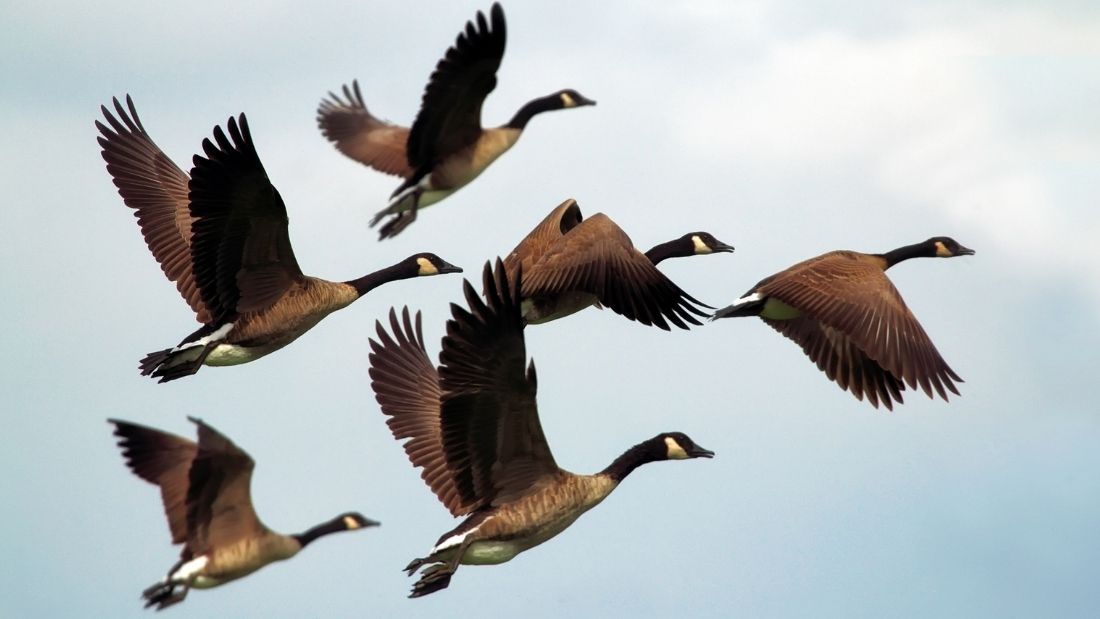
Number of farmed ducks and geese in the UK
Around 11 million ducks and geese are slaughtered in the UK each year.1https://assets.publishing.service.gov.uk/government/uploads/system/uploads/attachment_data/file/1034693/AUK-2020-19nov21.pdf. [Accessed 25 November 2021]
Ducks and geese account for 1.7% per cent of total poultry production in the UK.1DEFRA, 2019a. Agriculture in the United Kingdom 2018. Available at: https://assets.publishing.service.gov.uk/government/uploads/system/uploads/attachment_data/file/848641/AUK_2018_09jul19a.pdf [Accessed 12 May 2020]. Ducks, geese and turkey production together are worth on average £376 million per year (years 2014 to 2018).1DEFRA, 2019a. Agriculture in the United Kingdom 2018. Available at: https://assets.publishing.service.gov.uk/government/uploads/system/uploads/attachment_data/file/848641/AUK_2018_09jul19a.pdf [Accessed 12 May 2020].
The major duck producing countries of the world are China and other Southeast Asian countries which together account for over 90 per cent of the annual world production of 1,500 million ducks.
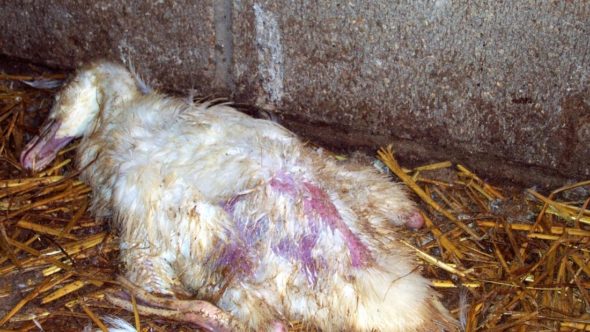
Breeds of farmed ducks and geese
Farmed ducks are broadly divided into two types: the Mallard-type (Anas Platyrhynchos) and the Muscovy duck (Cairina Moschata).
The most commonly bred duck for meat and eggs in the UK is the White Pekin duck, originally bred over many centuries from the Mallard in China. Other domesticated Mallard breeds include the Aylesbury, Gressingham and Rouen ducks.
The Muscovy (or Barbary) duck is bred mainly for breast meat and for the shockingly cruel production of foie gras. The Moulard (or Mulard) is a sterile cross between a Muscovy duck and a White Pekin. This breed is used for foie-gras.
There are two main types of domestic geese. Descendants of the Greylag goose and the wild Swan goose. Crosses between the domestic breeds which have originated from these two species of wild geese are fertile and have resulted in a number of recognised breeds. The most commonly farmed goose for meat in the UK is the Legarth goose.2Clarke, P., 2015. How the UK’s largest goose producer rears its birds. 12 August. Farmers Weekly. Available at https://www.fwi.co.uk/livestock/poultry/poultry-business/revealed-uks-largest-goose-producer-rears-birds [Accessed 20 May 2020].
Also see foie gras.
Systems of rearing
Indoor Units.
The majority of ducks are reared indoors in the UK. Up to 10,000 ducks are crammed together in each shed with dim but almost constant lighting on a straw litter floor. Little or no night-time rest is provided so that they continue to eat around the clock and gain weight rapidly. Despite being aquatic birds, they live in grossly overcrowded sheds, eat pelleted food and drink water from shallow drinking points or nipple drinkers. At Gressingham Foods, one of the UKs largest intensive duck producer, each drinking point served 130 birds!3Dalton, J., 2019. ‘A life of misery’: Undercover filming shows ducks stuck on their backs and denied access to open water at Gressingham farms. The Independent. 17 December. Available at https://www.independent.co.uk/news/uk/home-news/duck-sainsbury-waitrose-tesco-asda-morrisons-cruelty-gressingham-foods-a9248956.html [Accessed 15 June 2020]. Some farmers offer ducks bell drinkers which just about allows the birds to dip part of their head underwater – they are certainly not large enough to swim in.2Clarke, P., 2015. How the UK’s largest goose producer rears its birds. 12 August. Farmers Weekly. Available at https://www.fwi.co.uk/livestock/poultry/poultry-business/revealed-uks-largest-goose-producer-rears-birds [Accessed 20 May 2020]. Webbed feet, evolved for swimming, and bills brilliantly designed to sieve food particles from rivers and ponds, are both entirely redundant.
Welfare recommendations allow as little as one m2 for up to eight ducks of three to eight weeks old.4DEFRA, 2011a. Ducks (England): Code of Recommendations for the Welfare of Livestock (PB0079). Availabe at http://adlib.everysite.co.uk/adlib/defra/content.aspx?id=000IL3890W.180G7LHF5MSJ8A [Accessed 20 May 2020]. Adult breeding ducks, who spend far longer in captivity, are allowed one m2 between up to five ducks.
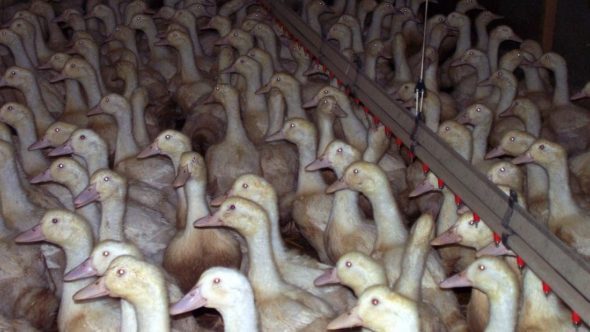
Free range.
Free-range birds are provided with outside space to roam during the day while being housed indoor at night. In a grass run, 2,500 to 5,000 ducklings are allowed per hectare of land and for adult ducks it is 4,000 per hectare,4DEFRA, 2011a. Ducks (England): Code of Recommendations for the Welfare of Livestock (PB0079). Availabe at http://adlib.everysite.co.uk/adlib/defra/content.aspx?id=000IL3890W.180G7LHF5MSJ8A [Accessed 20 May 2020]. still grossly overcrowded by any standard.
More than half of the geese farmed in the UK are reared indoors for three weeks until they’re moved outdoors for daytime grazing for up to 21 weeks before they are slaughtered.
Gressingham is the UK’s largest goose producer, farming half of all geese slaughtered each year in the UK. Gressingham rears 90,000 free-range geese in Norfolk annually, with most of them killed for the Christmas period.2Clarke, 2015. How the UK’s largest goose producer rears its birds. 12 August. Farmers Weekly. Available at https://www.fwi.co.uk/livestock/poultry/poultry-business/revealed-uks-largest-goose-producer-rears-birds [Accessed 20 May 2020]. The goslings arrive in batches of 5,000 birds when they are just a few days old. They are then kept indoors for three weeks before being allowed outside.2Clarke, P., 2015. How the UK’s largest goose producer rears its birds. 12 August. Farmers Weekly. Available at https://www.fwi.co.uk/livestock/poultry/poultry-business/revealed-uks-largest-goose-producer-rears-birds [Accessed 20 May 2020].
Some people argue that because geese are mostly farmed outdoors, they are a more ethical choice of animal to eat than other birds such as turkeys. But farming animals outdoors does not offer any sort of guarantee that there will be high animal welfare. Geese farming is simply outdoor factory farming, where the animals are overcrowded, forced to live in filth and unable to express their natural behaviour.
Most people are familiar with the sight of happy ducks, swans and geese swimming and floating on rivers and lakes. Geese are a type of waterfowl, adapted to live with water, but there is no obligation for farmers to provide water other than drinking water, even though geese need water to clean their feathers and eyes, express their natural behaviour and play. Water is also vital in allowing geese to cool off in hot weather to avoid heat stress, which can kill.5DEFRA, 2019b. ‘Poultry: welfare recommendations.’ Department of Environment, Food and Rural Affairs, 5 July. Available at https://www.gov.uk/government/publications/poultry-on-farm-welfare/poultry-welfare-recommendations [Accessed 25 November 2020]. Whether ‘free-range’ or not, this need is entirely ignored in geese farming.
Like many animals, young birds imprint on the first moving object they find and see that animal as their mother. As these birds have been removed from their mothers and never see them, they instead imprint on workers on the farm and follow them around, desperately trying to get their attention.2Clarke, P., 2015. How the UK’s largest goose producer rears its birds. 12 August. Farmers Weekly. Available at https://www.fwi.co.uk/livestock/poultry/poultry-business/revealed-uks-largest-goose-producer-rears-birds [Accessed 20 May 2020]. While this is sometimes portrayed as nothing more than a cute story, these animals are in fact desperately trying to attract motherly attention. Workers are not on the site anywhere near as much as the goslings need for their imprinted parent, nor do they provide the nurturing that the goslings require, and it only adds to their confusion and distress.
Although farmers shoot predators, gulls and foxes still pick off the young and mortality rates are high at six to eight per cent.2Clarke, P., 2015. How the UK’s largest goose producer rears its birds. 12 August. Farmers Weekly. Available at https://www.fwi.co.uk/livestock/poultry/poultry-business/revealed-uks-largest-goose-producer-rears-birds [Accessed 20 May 2020]. While predation is a part of nature in the wild, farmers are keeping thousands of extremely young birds together in highly unnatural conditions – they are kept in fenced areas where they have no way of escaping or flying away or mothers to protect the chicks as they would in the wild. At the same time, poor nutrition in ducks and geese can lead to ‘angelwing’, a severe wing deformation caused by too much protein in the diet which renders the birds unable to fly away, which is their main defence against predators. They are truly sitting ducks with no chance of escape from predators who break into the fenced-in areas.
Just because an animal is farmed outdoors, it does not mean they are given a natural environment or that their needs are met beyond keeping them alive. Even in supposedly free range farms, Viva! has investigated and found geese left to die, trampled on by their inmates or left to die of illness, including on Gressingham farms. And of course, no matter how ‘free range’ the farm actually is, these birds are killed years before their time. While geese can live for up to 15 years in the wild,6Encyclopaedia Britannica, 2020. ‘Goose.’ Encyclopaedia Britannica, 11 March. Available at https://www.britannica.com/animal/goose-bird [Accessed 15 January 2021] they are killed at a maximum of 24 weeks of age in farms, whether free range or not, and must be absolutely petrified when taken to slaughter.
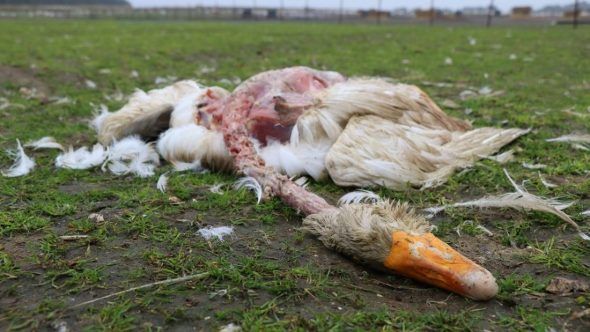
Dead goose on a free-range farm
Life on Factory Farms
Factory farmed ducks and geese cannot fulfil their natural desire and need to swim, preen, play and feed in water. At best, they may be able to dip their head into water baths which help them to some degree with cleaning their eyes and nose. They cannot fly when they are naturally migratory animals. They cannot protect their young as they never see them.
Duck sheds are overcrowded and utterly boring places which can lead to aggression due to frustration and lack of space.
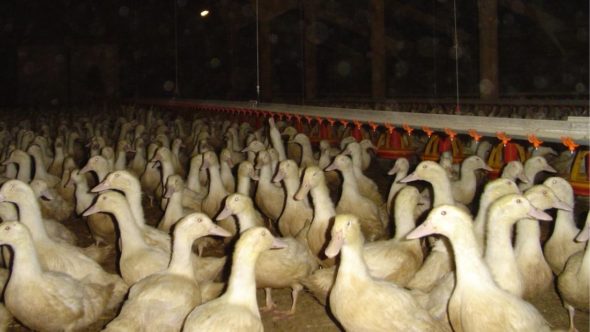
Mutilations
The UK government doesn’t allow any mutilations which injure wing tissue, however,
Muscovy (Barbary) ducks have the end of their bills cut off to reduce injuries of birds through pecking, allowed by the government ‘only when it is clear that more suffering would be caused in the flock if it were not done’.4DEFRA, 2011a. Ducks (England): Code of Recommendations for the Welfare of Livestock (PB0079). Availabe at http://adlib.everysite.co.uk/adlib/defra/content.aspx?id=000IL3890W.180G7LHF5MSJ8A [Accessed 20 May 2020].7DEFRA, 2011b. Management Bill trimming. Available at http://adlib.everysite.co.uk/adlib/defra/content.aspx?id=000IL3890W.180GBFNL3RKJB1 [Accesses 20 May 2020].5DEFRA, 2019b. Ducks (Mallard and Pekin): welfare recommendations. 5 July. Available at https://www.gov.uk/government/publications/poultry-on-farm-welfare/ducks-mallard-and-pekin-welfare-recommendations [Accessed 20 May 2020].7Farming Ducks. Available at https://www.rspca.org.uk/adviceandwelfare/farm/ducks/farming [Accessed 8 June 2020]. That’s not the case for Pekin ducks though.
The Muscovy duck has a sharp bill, unlike Mallard-type ducks, and can inflict serious injury. It is also richly innervated (supplied with nerves) and very well endowed with sensory receptors. Their bills are trimmed with an infrared laser which causes the sharp tip of their bill to blunt.10Farmers Weekly, 2019. ‘What UK farmers can learn from German turkey beak trim ban’. Available at: https://www.fwi.co.uk/livestock/poultry/other-poultry/advice-on-managing-turkeys-without-beak-treatment [Accessed 20 April 2020]. It is a pain likened to that suffered by human amputees.
Rather than change the conditions under which birds are kept, to reduce aggression, the mutilation is sanctioned, despite powerful evidence that it causes birds acute pain and seriously affects their behaviour.11Gustafsona, L., Cheng, H., Garnerc, J., Pajorc, E., Mencha, J., 2007). Effects of bill-trimming Muscovy ducks on behavior, body weight gain, and bill morphopathology. Applied Animal Behaviour Science. Available at https://www.sciencedirect.com/science/article/abs/pii/S0168159106001031 [Accessed 20 May 2020]. It can lead to a reduction in the effectiveness of their pecking and reduced feedback from the beak, together with increased dozing, general inactivity and depression.
Scientists have shown that “debeaking of ducklings is […] traumatic to the bird as the beak is innervated up to the tip”. And that “the use of outside runs considerably reduces pecking”.12Raud and Faudre, 1994. Welfare of ducks in intensive units. Revue Scientifique et Technique de l’Office International des Epizooties. Available at https://www.oie.int/doc/ged/D8875.PDF [Accessed 20 May 2020]. In flocks of breeding Muscovy ducks another form of pecking can occur, directed at red regions, namely the cloaca of males and females. In addition, it is becoming “increasingly common to observe females harassing males by nipping their penis, sometimes to the point of irreversible mutilation, before it has retracted after mating”. This abnormal behaviour is likely caused by a poor environment and overcrowding.12Raud and Faudre, 1994. Welfare of ducks in intensive units. Revue Scientifique et Technique de l’Office International des Epizooties. Available at https://www.oie.int/doc/ged/D8875.PDF [Accessed 20 May 2020].
Breeding
Ducks and geese are selectively bred to grow faster and bigger than is natural. Specialised breeders supply duck and geese farmers with ducklings and gosling from breeding programmes chosen for producing birds with a good commercial (money making) performance. Criteria are for the amount of breast meat, weight, leanness and general health.13UFAW, 2011. Management and welfare of farm animals. Wiley-Blackwell.
Cherry Valley , the world’s leading duck breeder, selectively bred the Pekin duck – the Super M3’ – stating that she produces 240 ducklings in a 50 week laying cycle.14Cherry Valley Farms Ltd, 2020. Products and Specifications. Available at https://www.cherryvalley.co.uk/enquiriesandspecifications [Accessed 26 May 2020]. Naturally, a wild Mallard from which the Pekin is descended, lays only 12 eggs a year.
The breeding period of geese is naturally highly seasonal and is why breeders work with artificial lighting to artificial manipulate seasons in order to increase egg production.
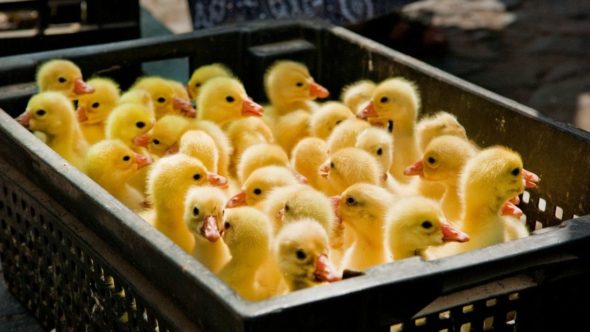
Eggs, ducklings and goslings
Females ducks begin laying eggs from 24 weeks old. If it is fertilized, the egg hatches after an incubation period of 28 days. For geese the incubation period is between 29 and 35 days.
The fulfilment of maternal instincts is denied in today’s commercial breeding operations. Observation of mother ducks and geese with their young unsurprisingly shows a very strong bond. In the wild, female Mallards usually look after their ducklings for about two months but in commercial farms, of course, they never see their mother and are killed before this age.
After hatching, ducklings and goslings are transported to growing sheds where they’re usually reared with tens of thousands of other young until reaching slaughter weight at seven weeks (ducks) and 10 or 24 weeks (geese). High temperatures inside the sheds, overcrowding, bullying and starvation result in many deaths.
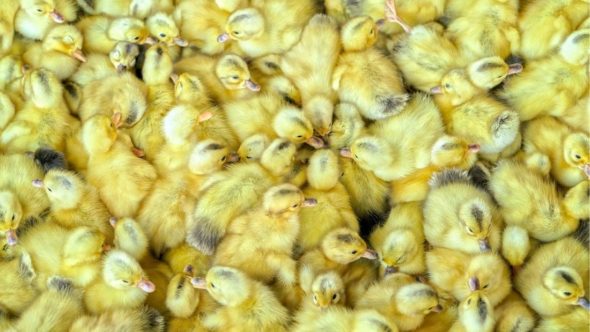
Diseases and illnesses
With factory farming becoming ever-more intensive, with it, disease control becomes more difficult. With thousands of animals crammed into small sheds in unhygienic conditions, viruses and bacteria spread like wildfire.
The aquatic nature of ducks, who will splash water around given the chance, makes it difficult to keep a dry environment in factory farms and that makes disease management more difficult.15King, E., 2017. Infectious diseases affecting UK commercial duck species. 6 March. Available at https://www.vettimes.co.uk/app/uploads/wp-post-to-pdf-enhanced-cache/1/infectious-diseases-affecting-uk-commercial-duck-species.pdf [Accessed 27 May 2020]. Ducks can be asymptomatic carriers of diseases, such as avian influenza (they carry the virus but don’t show any symptoms). According to poultry vet Keith Gooderhan, who worked for Cherry Valley ducks in the UK “…loss from diseases [in duck factory farms] can be considerable.”13UFAW, 2011. Management and welfare of farm animals. Wiley-Blackwell.
The most common infectious diseases in UK duck farming are duck viral hepatitis, duck viral enteritis, Riemerella anatipestifer, E coli, Streptocooccal and aspergillus infections. Other notifiable diseases are avian influenza and Newcastle disease. Many of those diseases have a high mortality rate and duck viral hepatitis, for example, has a death rate of 90 per cent.16Palya, V., 2011. Major viral disease of waterfowl and their control. International Poultry Production, 19(4), pp.21-26. Available at http://www.bvpa.org.uk/pdfs/palya1011.pdf [Accessed 27 May 2020].
Geese in particular are very sensitive when it comes to nutrition. Poor nutrition can lead to ‘angelwing’, a severe wing deformation – too much protein causes the flight feathers to grow unnaturally fast and the skeleton system can’t keep pace.17Lin, M., Chang, S., Lin, T., Cheng, Y., 2015. Factors Affecting the Incidence of Angel Wing in White Roman Geese: Stocking Density and Genetic Selection. Asian Australasian Journal of Animal Sciences. Available at https://www.researchgate.net/publication/282389133_Factors_Affecting_the_Incidence_of_Angel_Wing_in_White_Roman_Geese_Stocking_Density_and_Genetic_Selection [Accessed 27 May 2020].
Ducks and geese, both being domestic waterfowl, are susceptible to a range of similar diseases as well as diseases carried by other poultry such as chickens and turkeys.
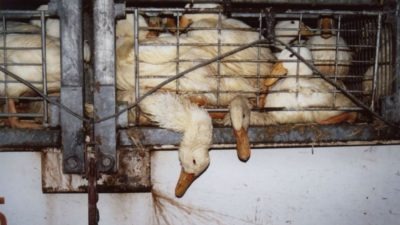
Foie gras
Foie gras is fatty duck or goose liver. By French law the animals are fattened through an intensive force-feeding process. In some other countries the birds may be fed more naturally, but this is by far the minority.
Ducks account for 95 per cent and geese the remaining 5 per cent of foie gras production. The Muscovy (Barbary) duck and the hybrid cross of a male Muscovy duck and a female Pekin duck called the Moulard (or Mulard) duck are mainly used.
Foie gras production was banned in the UK in 2000 but it is still imported from abroad, with 98 per cent coming from France.18BBC, 2018. Foie gras imports may be banned after Brexit, UK minister suggests. 14 June. Available at https://www.bbc.co.uk/news/uk-politics-44480768 [Accessed 13 May 2020]. The UK imports 180 to 200 tonnes of foie-gras each year and Environment Minister, George Eustice, told MPs that the import of foie-gras could be banned when the UK leaves the EU. Following a persistent campaign by Viva!, many UK supermarkets, retailers and restaurants have already banned its sale, having been persuaded that its method of production is immense cruelty. However, customers can still buy it online but not from Amazon, who Viva! persuaded to stop selling it.
Of all the world’s duck foie gras, 83 per cent is produced in France, along with 25 per cent of geese foie-gras,2118BBC, 2018. Foie gras imports may be banned after Brexit, UK minister suggests. 14 June. Available at https://www.bbc.co.uk/news/uk-politics-44480768 [Accessed 13 May 2020].[/mfn] where the law defends its production as part of the country’s cultural and gastronomic ‘heritage’. Foie gras cannot be sold as French unless it is the result of force feeding (gavage).
Foie gras production is banned in several countries, including most of the Austrian provinces, the Czech Republic, Denmark, Finland, Germany, Italy, Luxembourg, Norway, Poland and Israel. General animal protection laws in Ireland, Sweden, Switzerland, the Netherlands and the United Kingdom mean that production is also essentially banned.
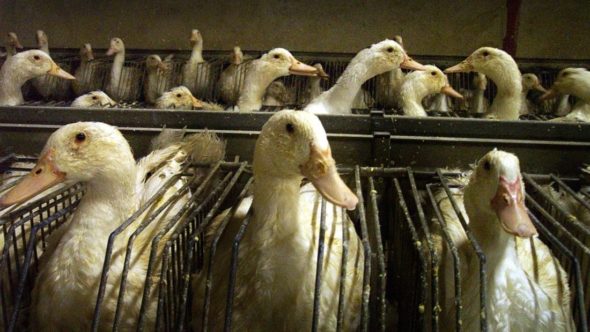
Production of foie gras
Ducks and geese are force-fed by a process known as gavage, when the birds are force fed far more food than they could ever voluntarily eat. Feed is usually comprised of corn boiled with fat, which deposits large amounts of fat in the liver and diseases it (hepatic steatosis) and would invariably be fatal if the birds were not first slaughtered. As it is, many don’t survive this cruel process with the mortality rate of force-fed birds being more than 10 times higher than that of birds who are not force-fed.19Skippon, 2013. The animal health and welfare consequences of foie gras production. The Candadian Veterinary Journal. Available at https://www.ncbi.nlm.nih.gov/pmc/articles/PMC3595949/ [Accessed 13 May 2020].
Force-fed birds are held in tiny cages and have no means of escape. They are grabbed and food is pushed down a funnel which is forced in their throats and then into their stomachs. Modern systems use a tube fed by a pneumatic or hydraulic pump. Force-feeding can cause violent trauma to the bird’s oesophagus, which in turn can be fatal. The aim is to force the liver to swell up to 10 times its natural size impairs its proper function, expands the abdomen, making it difficult for birds to walk (if they were allowed to) and scars the oesophagus.19Skippon, 2013. The animal health and welfare consequences of foie gras production. The Candadian Veterinary Journal. Available at https://www.ncbi.nlm.nih.gov/pmc/articles/PMC3595949/ [Accessed 13 May 2020].
Ducks raised for foie gras are reared in barns until their plumage develops when they may be allowed free access to feed and the outdoors. At just 12 weeks old they are moved to intensive housing in the tiniest of cages where they are force-fed.19Skippon, 2013. The animal health and welfare consequences of foie gras production. The Candadian Veterinary Journal. Available at https://www.ncbi.nlm.nih.gov/pmc/articles/PMC3595949/ [Accessed 13 May 2020]. The birds are force fed twice a day over a period of 16 days for geese, 12 for ducks.20Euro Foie Gras, 2019. The production. Available at https://www.eurofoiegras.com/en/the-production/ [Accessed 13 May 2020]. Ducks are typically slaughtered at 100 days and geese at 112 days.

Poultry scientists have ‘perfected’ selective breeding and have engineered fast growth rates to maximimise profitability in species with potential lifespans of 10 to 20 years. Today’s commercially-farmed ducklings are slaughtered at around seven weeks old (42 to 56 days old). Geese are killed at around 10 weeks old for lightweight “green” birds or around 24 weeks.
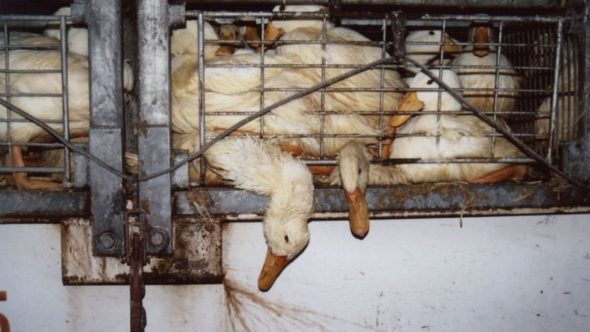
Around 11 million ducks and geese are slaughtered in the UK each year1https://assets.publishing.service.gov.uk/government/uploads/system/uploads/attachment_data/file/1034693/AUK-2020-19nov21.pdf [Accessed 25 November 2021]. and along with the majority of poultry, are gassed to death. Gas stunning is often referred to as Controlled Atmosphere Stunning or CAS systems. Birds remain inside their transport crates, which are placed into special containers where they are killed by a mixture of air and gas. Birds can headshake and gasp with a low concentration of carbon dioxide and if inert gases are uses, birds show distress with vigorous wing flapping and convulsions, as a result of the hypoxia.2Berg, C & Raj, M, 2013. https://www.ncbi.nlm.nih.gov/pmc/articles/PMC4693211/ [Accessed 15 June 2020]. UK legislation states that they must be exposed to a deadly amount of gas – it is not legal to simply stun them.
The other main slaughter method is throat cutting preceded by electrical stunning. Live animals are hung up by their feet in metal shackles and are moved along an overhead conveyor system. This process causes major pain and stress. They are stunned by having their heads dragged through an electric water bath, after which they move on to a mechanical neck cutter, which cuts the major blood vessels in the neck. As some animals lift their necks to avoid the stun bath and mechanical neck cutter, many are still conscious when they’re dipped into a scalding tank to loosen their feathers, where the water temperature is up to 58 degree C – they are essentially boiled alive.
If a farmer kills less than 10,000 birds a year which are sold locally they can be killed on farm.3DEFRA, 2015a. Slaughtering poultry, rabbits and hares on farms for small-scale suppliers. Available at https://www.gov.uk/guidance/slaughtering-poultry-rabbits-and-hares-on-farms-for-small-scale-suppliers [Accessed 28 May 2020]. They can be killed using cervical (neck) dislocation by hand for birds up to 3 kg or birds – their necks are broken. For birds between 3 and 5kg, a mechanical neck dislocator can be used. For purposes of religious slaughter, all poultry can have their throats cut by hand without pre-stunning and it can take them up to two minutes to die.4DEFRA, 2015b. Halal and kosher slaughter. Available at: https://www.gov.uk/guidance/halal-and-kosher-slaughter [Accessed 22 April 2020]. A long and painful death.
The industry
The UK is the fourth largest producer of duck meat in the EU.5Newton, J., 2012. ‘An overview of the UK Duck Industry’. ADAS. Available at http://randd.defra.gov.uk/Document.aspx?Document=13034_OZ0345Finalreport.pdf [Accessed 1 Mai 2020].
UK-based Cherry Valley Foods used to be one of the world’s largest duck producers. In 2015, Avara (previously Faccenda) purchased the company which gave it the unique position of being the only producer who produces all of these three species: chicken, duck, and turkey. However, in April 2020, there was fantastically good news when Avara announced a proposal to close its duck business due to ‘increasingly difficult external market conditions’ – European competition, a drop in feather prices and feed costs.6Ryan, C., 2020. Avara Foods announces proposal to close its duck business. 30 April. Available at http://www.poultrynews.co.uk/production/ducks/avara-foods-announces-proposal-to-close-its-duck-business.html [Accessed 20 May 2020].
Gressingham Foods kills about eight million ducks pa, which are wild Mallards crossed with Pekin ducks.7Dalton, J., 2019. ‘A life of misery’: Undercover filming shows ducks stuck on their backs and denied access to open water at Gressingham farms. The Independent. 17 December. Available at https://www.independent.co.uk/news/uk/home-news/duck-sainsbury-waitrose-tesco-asda-morrisons-cruelty-gressingham-foods-a9248956.html [Accessed 15 June 2020]. They boast “We produce about 130,000 ducks a week for restaurants, hotels and supermarkets”.8Guardian, 20 April 2013. https://www.theguardian.com/lifeandstyle/2013/apr/20/meet-producer-gressingham-ducks [Accessed 15 June 2020]. They are one of the UK’s largest intensive producer of ducks. They are also the largest goose producer in the UK, rearing 90,000 free-range Legarth birds in Norfolk every year.9Clarke, P., 2015. How the UK’s largest goose producer rears its birds. 12 August. Farmers Weekly. Available at https://www.fwi.co.uk/livestock/poultry/poultry-business/revealed-uks-largest-goose-producer-rears-birds [Accessed 20 May 2020]. Most of these geese are sold for the Christmas market.

